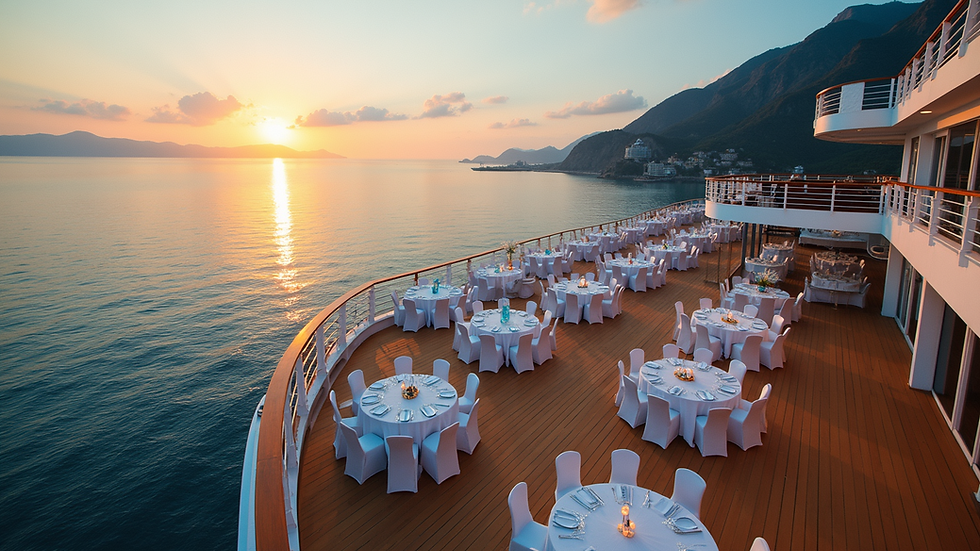Mastering Cruise Ship Event Production Logistics
- Captain

- Sep 26
- 4 min read
Navigating the vast ocean of event production on cruise ships demands precision, strategy, and a fearless spirit. I steer through the complexities of logistics with the confidence of a seasoned captain. Every detail matters. Every wave of challenge is an opportunity to showcase mastery. This cruise event planning guide charts the course for flawless execution, turning floating venues into unforgettable branded experiences.
Setting Sail: The Cruise Event Planning Guide Essentials
Planning an event on a cruise ship is like commanding a vessel through unpredictable waters. You need a clear map, a skilled crew, and the right tools. The first step is understanding the unique environment. Cruise ships are self-contained cities with strict regulations, limited space, and tight schedules.
Key factors to consider:
Venue limitations: Spaces are fixed and multifunctional. Adapt your event design to fit the ship’s layout.
Timing: Coordinate with the ship’s itinerary. Events must align with port stops, onboard activities, and guest availability.
Permits and compliance: Maritime laws and ship policies govern what you can and cannot do.
Technical infrastructure: Power supply, internet connectivity, and rigging points differ from land venues.
I always start by collaborating closely with the ship’s event coordinators. Their insider knowledge is invaluable. They help navigate restrictions and unlock hidden opportunities.

Eye-level view of cruise ship event hall with stage setup
Charting the Course: Logistics That Keep the Ship Afloat
Logistics is the backbone of any successful cruise event. It’s the engine room where planning turns into action. I break down logistics into manageable segments to avoid chaos.
1. Equipment and Cargo Management
Shipping gear to a cruise ship is a high-stakes game. Space is limited, and timing is critical. I recommend:
Early coordination: Confirm shipping windows and dock access with the cruise line.
Compact packing: Use modular, lightweight equipment to maximize space.
Customs clearance: Prepare all documentation for international ports to avoid delays.
2. Staffing and Crew Coordination
Your team must function like a well-oiled machine. Assign clear roles and establish communication protocols. Use walkie-talkies or ship-approved communication devices to stay connected.
3. Setup and Breakdown Timing
The clock is your enemy and ally. Setup often happens during off-peak hours or overnight. Breakdown must be swift to avoid interfering with the ship’s schedule.
4. Safety and Emergency Protocols
Safety is non-negotiable. Familiarize your team with the ship’s emergency procedures. Conduct briefings before every event.

High angle view of cruise ship loading dock with event equipment
What is the 3:1:1 rule on cruises?
The 3:1:1 rule is a crucial guideline for managing time and resources on cruise events. It stands for:
3 hours of setup
1 hour of event duration
1 hour of breakdown
This rule helps maintain a tight schedule and ensures smooth transitions between events. It forces planners to be efficient and focused. I use this rule as a benchmark to allocate resources and manpower effectively.
For example, if you have a one-hour keynote, you must plan for three hours of setup to handle technical checks, staging, and rehearsals. After the event, one hour is reserved for teardown and clearing the space for the next activity.
This rule keeps the ship’s rhythm intact and prevents bottlenecks. It’s a lifesaver when managing multiple events on a single voyage.
Navigating Technical Seas: Audio, Visual, and Lighting Mastery
Technical production on a cruise ship is a different beast. The environment challenges sound engineers, lighting designers, and AV technicians alike. Salt air, metal walls, and constant movement affect equipment performance.
My approach:
Use marine-grade equipment: Designed to withstand humidity and vibration.
Test everything onboard: Conduct sound checks and lighting rehearsals in the actual venue.
Plan for redundancy: Have backup gear ready to avoid show-stopping failures.
Integrate with ship systems: Coordinate with the ship’s AV team to use existing infrastructure.
Lighting is your secret weapon. It transforms sterile ship interiors into immersive branded environments. Use dynamic lighting to mimic ocean waves, sunsets, or starry skies. This creates emotional connections and elevates the guest experience.

Close-up view of stage lighting setup on cruise ship
Anchoring Brand Impact: Creating Unforgettable Experiences
The ultimate goal is to turn the cruise ship into a floating billboard for your brand. This requires creativity and strategic thinking.
Tactics I deploy:
Themed environments: Use décor, props, and interactive elements that align with the brand story.
Engagement zones: Create spaces for networking, product demos, and social media moments.
Exclusive experiences: Offer VIP areas, meet-and-greets, or behind-the-scenes tours.
Seamless integration: Ensure branding is visible but not overwhelming. Balance is key.
Every event is a voyage. I chart a course that captivates guests from embarkation to disembarkation. The ship becomes a controlled marketing environment where every touchpoint reinforces the brand message.
For those seeking expert guidance, Cruise Ship Event Production offers unparalleled services. They specialize in transforming vessels into high-impact branded experiences worldwide.
Steering Toward Success: Final Thoughts on Cruise Event Mastery
Mastering cruise ship event production logistics is a voyage of precision, creativity, and relentless execution. The sea tests your resolve, but with the right strategy, you command the waves.
Remember:
Plan meticulously and communicate relentlessly.
Respect the ship’s ecosystem and work within its framework.
Prioritize safety and technical excellence.
Craft immersive, branded experiences that leave lasting impressions.
The ocean is vast, but your event’s impact can be boundless. Set your sails, chart your course, and make waves that resonate long after the ship docks.




Comments